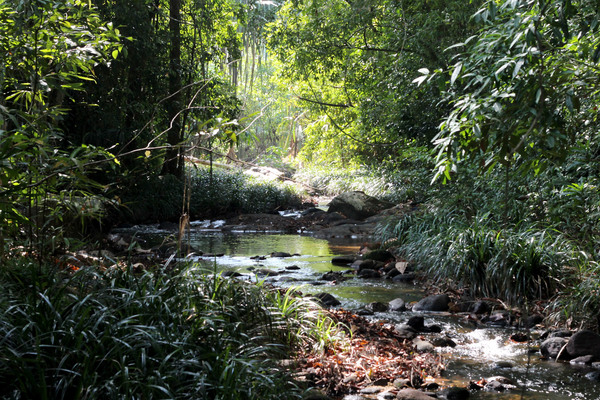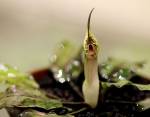An easy find: Cryptocoryne cordata var. siamensis
The exact coordinates of the Cryptocoryne habitats belong to exclusive information and are usually not openly published either in scientific articles nor in collectors' blogs. It is not worth criticizing them, this is their bread and butter, and sometimes just good intentions focusing on preserving plants in nature. Me and my colleagues went on a February trip to Southern Thailand without informational preparation, relying only on our luck. It turned out that luck in this country often favors travelers. Having traveled a long way (more than 200 km) south from Ranong city with a stop at the coral Surin Islands, we stopped at one of the roadside hotels in the Khao Lak resort. For the first time in the seven days of the journey, we took the decision to stay at the same hotel for more than one night in order to get some rest, and therefore the plans for the next day only included visiting several small streams flowing into the Andaman Sea. Those streams were at a distance of just 10-20 km from the hotel (Photo 1).
Photo 1. The small river Bang Niang near the Khao Lak Resort in Thailand is the habitat of Cryptocoryne cordata var. siamensis. Photo by Dmitry Loginov.
But even this was enough to record another productive day in the expedition report. After an unhurried breakfast, we first went to solve a more pressing problem - currency exchange. Unfortunately, due to the sanctions, the Russian traveler has to use only cash, which tends to run out unexpectedly. Having successfully filled our wallets with Thai baht, we reached the first stream only by noon. The stream flowed along the road leading to the Ton Chong Fa Waterfall, which belongs to the Khao Lak-Lam Ru National Park. We knew how high the prices for foreign tourists can be in such places, so we did not go to the source of the stream, but stopped the car on a road section with large tropical trees along the side of the road. Here, at least a little shadow fell on our vehicle, which gave us hope that it would not have time to turn into an oven in the hellish midday sun during the next hours.
The shadow covered not only the car, but also the main treasure of the stream - Cryptocoryne cordata var. siamensis (Photos 2 and 3). The plant was more like fallen tree leaves scattered carelessly on the bank. The gray metallic color of the front side of the leaf merged with the top layer of leaf litter. However, the very first attempt to lift the leaf gave out Cryptocoryne - the leaves turned out to be hard, and the reverse side of the leaf plate was bright crimson. The plant was stuck in the so-called "root ball" formed by the roots of trees along the banks of the stream, while the rocky bottom in the stream had no vegetation. In shady areas, Cryptocoryne did not bloom, and in the sun there were no single plants.
Photo 2. The gray leaves of Cryptocoryne cordata var. siamensis on the bank resemble leaf litter. Photo by Roman Magin.
Photo 3. The reverse side of the leaves of C. cordata var. siamensis is bright crimson. Photo by Dmitry Loginov.
The water in the habitat was neutral and quite soft (pH = 7.2, TDS = 20 ppm). Currently, in addition to var. siamensis, four more varieties of Cryptocoryne cordata are distinguished:
1. C. cordata var. cordata - Mainland Malaysia,
2. C. cordata var. diderici – Sumatra,
3. C. cordata var. wellyi – Sumatra,
4. C. cordata var. grabowskii – Kalimantan.
In situ, all these species live in acidic water with a pH of 4-6, which makes it difficult to keep them in an aquarium. At the same time, siamensis has been firmly established in the collections of domestic aquarists since the Soviet times. In those days, it was called Cryptocoryne blassii. Here is what Mark Makhlin, the famous Soviet aquatic plants expert, wrote about this plant: “C. blassii with wide oval leaves is distinguished by its original coloring" and "this Cryptocoryne is easily cultivated and sometimes reaches 50-60 cm in aquariums." Well, I cannot add anything else to this statement, everything has been already said.
Analyzing the literature, as well as our data obtained from different expeditions, we can draw on the map of Southeast Asia not only the Equator line, but also the hardness belt (see Map 1). It passes just north of the capital of Malaysia, the city of Kuala Lumpur, and touches the northern tip of the island of Sumatra. South of this belt, most of the rocks are of volcanic origin and they strongly acidify the water in local rivers. To the north, on the contrary, calcareous and shale rocks are present, what significantly increases the buffering of water. Among the most prominent representatives of the "northern hemisphere of the hardness globe" one can mention such easy-to-keep aquarium plants as Cryptocoryne affinis and Cryptocoryne pontederiifolia. C. cordata var. siamensis from Southern Thailand is “one heart and one flesh” with them!
Map 1. The "Hardness Belt" on the map of Southeast Asia.
The other stream was less picturesque, open to the sun and had a sandy bottom. We heard the furious barking of a pack of dogs nearby and this discouraged us from exploring a longer section of the stream. But even the thirty meter path along the stream was enough to broaden our knowledge about the biotopes of C. cordata var. siamensis. The most important thing is that the plant was blooming there at that moment (Photos 4 and 5). Short inflorescences with a bright yellow spathe protruded above the sand. Cryptocoryne plants were along the bank line, and also formed clumps in the riverbed, deepening its strong root system into the sand. It is likely that the weaker course in this area contributes to the siltation of sand, turning it into a quite reliable substrate for rooting. Nearby, several beds of Barclaya longifolia were found in the water. Its colorful leaves were sparkling in the rays of the tropical sun (Photo 6). Due to high daily solar insolation, the algal growth on the local aquatic plants was very active.
Photo 4. The Pak Wip River and its flowering C. cordata var. siamensis. Photo by Dmitry Loginov.
Photo 5. The Pak Wip River had a sandy, silted bed, which allowed us to observe the underwater C. cordata var. siamensis even in the dry season. Photo by Roman Magin.
Photo 6. Barclaya longifolia among fallen leaves. Its inflorescence is at the bottom left. It is interesting to note that unlike the Vietnamese island of Phu Quoc, in Thailand we have never seen large clusters of this plant. Most often, populations were limited to a couple of dozen specimens. Photo by Dmitry Loginov.
The bank vegetation at both streams also had some surprises. Firstly, the terrestrial Aroids picturesquely fit into the big picture: Rhaphidophora beccarii and Homalomena pontederiifolia (Photos 7 and 8). Secondly, which turned out to be unexpected, the Hevea brasiliensis plantations adjacent to the streams pleased us with the variety of orchids. Almost every trunk of this rubber plant was covered with epiphytes, among which we discovered Dendrobium acerosum (Photo 9).
Photo 7. A juvenile shoot of Rhaphidophora beccarii on the rocky bank of the Bang Niang River. Juvenile plants of Rhaphidophora are very different from adult specimens. Photo by Dmitry Loginov.
Photo 8. Adult specimens of Homalomena pontederiifolia on the banks of the Pak Wip River. The dissected inflorescence has faded a few days ago. Photo by Dmitry Loginov.
Photo 9. Dendrobium acerosum and other orchids on the trunk of Hevea brasiliensis. Unlike Malaysia, oil palm plantations in Thailand are not as numerous as the forests of Hevea brasiliensis. Despite the fact that the full cycle of growing this crop is only 40 years, all Hevea trunks are usually overgrown with orchids. Photo by Dmitry Loginov.
Angling in fast-moving streams is never an easy task. In shallow water, the fish are frightened and quickly swim downstream, or hide in snags. Nevertheless, we managed to catch several species for a photo session here too, among them Devario regina, Microdevario kubotai (Photo 10) and Rasbora paviana.
Photo 10. Microdevario kubotai. This golden Rasbora can be found here in almost every river. Named after the Thai aquarium fish exporter Katsuma Kubota. Photo by Dmitry Loginov.
A rare case when we familiarized with the Cryptocoryne biotopes and did not get tired. Thailand, following Vietnam, surprises with the availability and variety of species of both, Cryptocoryne and orchids.
Loginov, D. A. An easy find: Cryptocoryne cordata var. siamensis. Newslett. Int. Aroid Soc., 45(2)/2023, pp. 14–17.











